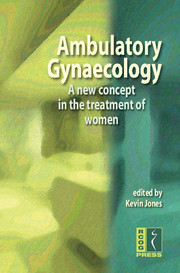Book contents
- Frontmatter
- Contents
- ABOUT THE AUTHORS
- ABBREVIATIONS
- PREFACE
- Chapter 1 Introduction
- Chapter 2 Anaesthesia and analgesia for outpatient gynaecology
- Chapter 3 Colposcopy services
- Chapter 4 Abnormal uterine bleeding
- Chapter 5 Endometrial ablation
- Chapter 6 Urogynaecology: urinary incontinence and genital prolapse
- Chapter 7 Infertility
- Chapter 8 Early pregnancy units and emergency gynaecological services
- Chapter 9 Pelvic utrasound and interventional radiology
- Index
Chapter 3 - Colposcopy services
Published online by Cambridge University Press: 05 June 2014
- Frontmatter
- Contents
- ABOUT THE AUTHORS
- ABBREVIATIONS
- PREFACE
- Chapter 1 Introduction
- Chapter 2 Anaesthesia and analgesia for outpatient gynaecology
- Chapter 3 Colposcopy services
- Chapter 4 Abnormal uterine bleeding
- Chapter 5 Endometrial ablation
- Chapter 6 Urogynaecology: urinary incontinence and genital prolapse
- Chapter 7 Infertility
- Chapter 8 Early pregnancy units and emergency gynaecological services
- Chapter 9 Pelvic utrasound and interventional radiology
- Index
Summary
Introduction
Colposcopy is probably the first example of a one-stop gynaecology service where the concept of a see-and-treat management philosophy was introduced successfully.
The colposcope was invented in 1925, by Hans Hinselman, and colposcopy was initially developed separately from cervical cytology. The introduction of acetic acid (1938) and the Pap test (1940) helped to develop colposcopy as a reliable diagnostic test, complementary to cytological screening. Owing to the invention, in 1989, of large loop excision of the transformation zone (LLETZ), which can be used in the outpatients setting, few situations still necessitate treatment under general anaesthesia.
In the UK, cervical cytology is used as a primary screening test and colpos-copy as a secondary tool (Figure 3.1). The NHS cervical screening programme was introduced in 1988 and is now acknowledged as a notable story of success, saving around 1,300 lives per year.
National targets: national service frameworks, guidelines and consensus documents
The British Society for Colposcopy and Cervical Pathology (BSCCP) and the Royal College of Obstetricians and Gynaecologists (RCOG) have produced guidelines for the provision of colposcopy services in the UK.
These guidelines emphasise the value of training, audit and team work and set standards of care. Previous standards that relate to quality in the colposcopy clinic, such as staffing, privacy and changing facilities, have been made more stringent. The views of women are also taken into account. All these changes may have resource implications but this is unavoidable if healthcare is to be quality driven.
- Type
- Chapter
- Information
- Ambulatory GynaecologyA New Concept in the Treatment of Women, pp. 28 - 35Publisher: Cambridge University PressPrint publication year: 2008



